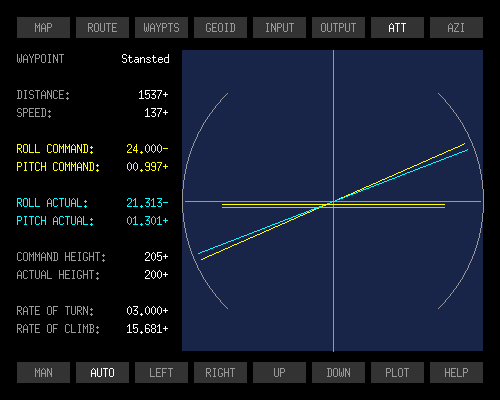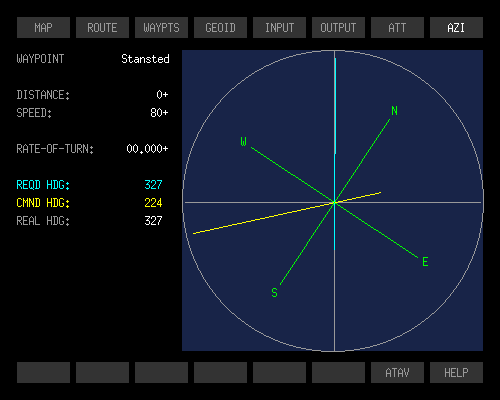During the TURN phase, the idea is for the aircraft to follow the turning arc. If the aircraft is outside the turning arc, it is directed along the tangent to the arc that lies in the direction of the outbound radial. During this phase, the point of reference for the aircraft is the centre of the turning arc: not the waypoint itself. This means that the aircraft's point of reference is always about 10 km away, so distance and bearing measurements are always reliable, being free from the wild variations that can occur at close proximity. Scan for [REF:TURN] in 'nav.c'.
 Under certain conditions, such as high winds, the aircraft can find itself inside the turning arc. In this case, the aircraft is directed along a heading at right-angles to the turning circle radius on which the aircraft currently lies. The required heading [ReqHdg] is simply the bearing of the centre of the turning circle [the aircraft's reference point] from the aircraft − π/2 [90°].
Under certain conditions, such as high winds, the aircraft can find itself inside the turning arc. In this case, the aircraft is directed along a heading at right-angles to the turning circle radius on which the aircraft currently lies. The required heading [ReqHdg] is simply the bearing of the centre of the turning circle [the aircraft's reference point] from the aircraft − π/2 [90°].
Note that the latitude and longitude of the centre of the turning arc are calculated for each of the waypoints in a route at route initialisation time in the program. Scan for [REF:TURNCTR] in 'nav.c'.
When the aircraft is beyond radio range of its current waypoint [assuming the waypoint is an active radio aid such as a VOR/DME station], it resorts to what I term 'trans-oceanic' mode. The aircraft obtains its current position [latitude/longitude] from a universally available source such as satellite-based global positioning systems [GPS, GLONASS, BeiDou, Galileo], an on-board inertial gyroscopic platform or a LORAN-style long-range hyperbolic radio-location system. Future systems could use natural phenomena such as pulsar signals, which would have the advantage of not being reliant upon sovereign or proprietary artificial infrastructures.
The trans-oceanic mode requires two waypoints. In the FROM case, where the aircraft is receding from its CURRENT waypoint, the second reference is the NEXT waypoint in the route. In the TO case, where the aircraft is approaching its CURRENT waypoint, the second reference is the PREVious waypoint. Scan for [REF: OCEANIC] in 'nav.c'.
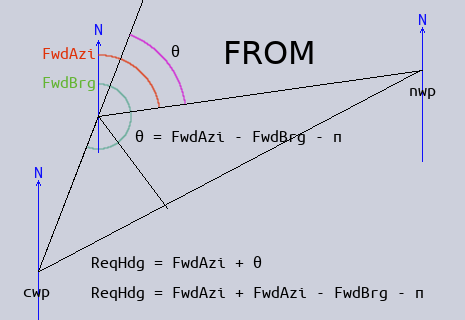 In the trans-oceanic FROM case, whenever the aircraft finds itself displaced laterally from the great circle that joins the current and next waypoints, it is steered such as to make an asymptotic approach back towards the great-circle. For this purpose, it is given a required heading according to the formula derived in the adjacent diagram. This uses the known bearings of each of the two waypoint from the point of view of the aircraft.
In the trans-oceanic FROM case, whenever the aircraft finds itself displaced laterally from the great circle that joins the current and next waypoints, it is steered such as to make an asymptotic approach back towards the great-circle. For this purpose, it is given a required heading according to the formula derived in the adjacent diagram. This uses the known bearings of each of the two waypoint from the point of view of the aircraft.
 The trans-oceanic TO case is the same, in principle as the FROM case. However, the formula appears somewhat different because the variables, from which the two bearings are obtained, need to be computed in the reversed sense. The formulae in both cases are safe for any displacement on the globe. An extreme displacement, however, could cause the aircraft to back-track in order to re-join the correct great-circle path.
The trans-oceanic TO case is the same, in principle as the FROM case. However, the formula appears somewhat different because the variables, from which the two bearings are obtained, need to be computed in the reversed sense. The formulae in both cases are safe for any displacement on the globe. An extreme displacement, however, could cause the aircraft to back-track in order to re-join the correct great-circle path.
A complete air route thus comprises a series of straight lines between waypoints [which are, in fact terrestrial great circles] joined together by the turning arcs [which are circular sections] at the waypoints themselves.
Notwithstanding, this is not the track really followed by the aircraft. This is because there are two second order discontinuities in the path. One is where the inbound radial joins the turning circle. The other is where the turning circle joins the outbound radial. A real object with real inertia, like an aircraft, cannot be travelling a straight path and then instantaneously switch to follow a circular path. Its inertia will constrain it at best to do the following:
When joining the turning arc from the inbound radial, the aircraft cannot avoid overshooting the turning arc while it is in the process of changing from a straight path to a curved path. It will, ideally, follow a spiralated asymptotic tangent to the turning arc.
When joining the outbound radial from the turning arc, the aircraft cannot avoid undershooting the outbound radial while it is in the process of changing from a curved path to a straight path. It will, ideally, follow a sigmoidated asymptotic tangent to the outbound radial.
So why, in the interests of purity, did I not opt to construct the inter-waypoint paths as hyperbolic attractors? The answer is that neither hyperbolas nor any other conic section or combinations of conic sections fit the bill. For a start, unless all pairs of consecutive waypoints in a route are equidistant, the hyperbolic sections will be asymmetrical. That in itself would create a point of second order discontinuity at the point of closest approach to each waypoint. Secondly, if a left turn is followed by a right turn or vice versa, the hyperbolic sections would not meet at the half-way point between consecutive waypoints. They would be off-set sideways.
Notwithstanding, the imaginable smooth trajectory of a route of waypoints does exist in reality. For example, if we imagine the aircraft to be an electron projected on a path that causes it to have close encounters with a sequence of 'anti-protonic' waypoints, it should, as a result of the repulsive electrical force, follow this imaginable smooth trajectory. But the 'world line' that the electron would follow is not hyperbolic. Nor is it any derivable combination of hyperbolas, parabolas or ellipses — nor even precessing relativistic rosettes. We have encountered what is traditionally known as the Three-Body Problem. Where three or more bodies are involved in a system of attractive or repulsive force fields, the world-lines followed by the bodies are smooth and continuous; but mathematically underivable. They can be computed only by fine-grained iterative means, as done in this program.
Mathematics — specifically, in this case, algebraic geometry — is an artificial language by means of which we try, as best we can, to express our rudimentary understanding of how nature works. But our mathematics is definitely NOT the way nature actually does it. Nature works according to its own very different rules. It is becoming increasingly apparent that these rules operate at a very fine grain and that they are generally focused one time derivative higher than we think mathematically.
An example showing that our mathematics is not the way nature does things is in this very program. It is embedded in the program's most fundamental function: the Vincenty algorithm for computing distance and bearing. This works fine everywhere except near the North and South poles. There it goes haywire. Notwithstanding, the space around the poles is, in reality, no different from the space anywhere else on the planet. If we were to shift the polar origin of our coordinate system of latitude and longitude to Paris and its antipode, then trajectories across the Arctic Sea or central Antarctica would be completely free from navigational anomalies. Thus, it is our mathematics that is the problem: not the fundamental nature of a spherical [or more strictly ellipsoidal] surface.
Consequently, there is nothing impure about taking the systemically pragmatic option of using straight lines and turning arcs as the aircraft's 'world line' attractor through its route of waypoints. Making a simple 'best fit' and then applying error correction is the best option. In fact, this intuitively appears to be much closer to the way nature fundamentally operates.
6. Distance Travelled & Updated Position
The anticipated distance the aircraft travels during the current pass of the program is the newly computed command speed [CmdSpd] multiplied by the elapsed time [ET] since the last time through. The anticipated distance the aircraft is blown by the wind during the current pass of the program is the wind speed [WndSpd] multiplied by the elapsed time [ET] since the last time through. The wind speed may be as computed from live inputs of the aircraft's latitude and longitude, or an internally simulated wind, according to whether live input is switched on or off.
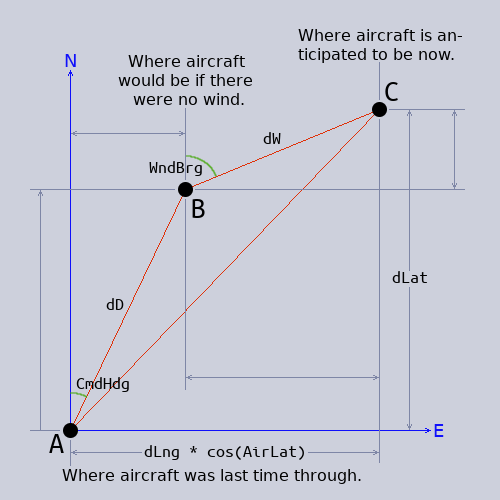 In the adjacent diagram, A is the position [latitude and longitude] of the aircraft at the end of the previous pass of the program. B is the new position the aircraft would have exclusively due to engine thrust. C is the new position of the aircraft when the effect of wind is added vectorially to the effect of engine thrust. The unannotated red line is the track followed by the aircraft as a result of the combined effects of engine thrust and wind. 'dLat' and 'dLng' are North and East components of the aircraft's displacement since the previous pass of the program. 'dLng' is multiplied by cos(AirLat) because longitudinal degrees represent that much shorter real distances than latitudinal degrees.
In the adjacent diagram, A is the position [latitude and longitude] of the aircraft at the end of the previous pass of the program. B is the new position the aircraft would have exclusively due to engine thrust. C is the new position of the aircraft when the effect of wind is added vectorially to the effect of engine thrust. The unannotated red line is the track followed by the aircraft as a result of the combined effects of engine thrust and wind. 'dLat' and 'dLng' are North and East components of the aircraft's displacement since the previous pass of the program. 'dLng' is multiplied by cos(AirLat) because longitudinal degrees represent that much shorter real distances than latitudinal degrees.
dLat and dLng are then respectively added to the previous latitude and longitude of the aircraft to get the new latitude and longitude of the aircraft.
7. Compute Required Height & Height Command
Scan for [REF:HEIGHT] in 'nav.c'. For the aircraft's passage between each pair of waypoints of the route, the updtHgt() function creates a sigmoidal path in the vertical plane beginning and ending respectively at points 100 metres above each of the 2 waypoints. This it does by referring to the standard monopolar sigmoid function shown below and then rescaling the height difference between the 2 waypoints and the distance between them. As shown, the function is for when the waypoint from which the aircraft is receding is lower than the waypoint it is approaching. For the converse case the sign of 'x' is reversed.

The updtHgt() function then attempts to move the aircraft, in the vertical plane, from its actual height, to merge asymptotically onto the height command sigmoid. This it does according to a simple iterative difference function. The aircraft height shown on the program's MAP tab is the command height to which the aircraft's autopilot or flight director must aspire.
This height control method lends itself well to stealth flight. Stealth flying, however, would require many more waypoints. In fact, every significant bump and pimple of the flight-track's terrain would have to be included in a route's sequence of waypoints. How low you can fly would be determined solely by how finely the route is waypointed. For covert stealth flights, the flight track's terrain profile would have to be carefully surveyed [probably from satellite photographs and radar imagery] and finely waypointed for every anticipated route in whatever part of the world.
The advantage of a finely graded waypoint route is that it can be flown silently. That is, it can be flown blind without having to use any active sensing devices such as ultrasonic or electromagnetic radar. Thus it can be flown in the dark without advertising the aircraft's presence to its surroundings.
Of course, obstacles to low flight may come and go. They can be temporary. In an adversarial situation, obstacles could be such things as strong nets spanning a valley. On-board sensory capability is therefore ultimately necessary. The first and most passive kind could be pitot pressure change sensors. Next could be visual or night-vision devices where the ambient conditions supply adequate illumination. But passive devices may have to trigger short bursts of active sensor operation where necessary. To minimise the risk of detection, these bursts would have to be kept as short as possible.
Aircraft Data & Map Display
The aircraft's position and data are updated by each pass of updtTrack() throughout a flight. This occurs every 5, 2 or 1 seconds, 500, 200 or 100 milliseconds according to the item selected in the Refresh Rate menu in Tab 2. Consequently, the visual display of the aircraft's flight data and map position must be re-displayed. This re-displaying is done by the function T0updt() at every pass of the clock loop in main(). However, T0updt() is also called after the default route has been initialised after the program is first started and also every time a new route is selected or a flight is reset.
The first action of T0updt() is to actualise the flight data figures on the left of the window. It then proceeds to update the map display. To do this, it scans through all the geographic features [including waypoints] in the currently selected route. For each geographic feature, it calls the Vincenty Inverse function to obtain its distance from the aircraft. The aircraft is always at the map centre. If the feature is within visible map range, it is shortlisted for display. Each geographic feature on the shortlist is then drawn and named in its appropriate position on the map.
Please note that in this C version of the program, unlike the Java version, non-English place names cannot contain accented letters. It is possible to include the extended font libraries but they were excluded to save space.
Once all the in-range geographic features have been drawn and named, the inbound and outbound radials plus the turning circle arc are drawn for the particular waypoint that is currently being referenced by the aircraft.
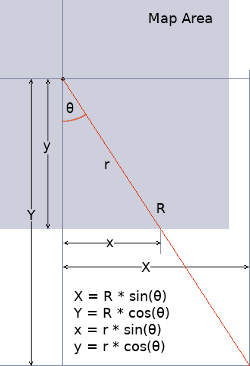 The C version of the program is so fast that it is not necessary to buffer the map graphics. However, the absence of graphics buffering makes it necessary to chop off any drawn object that would otherwise violate the boundary of the map area. The only offenders in this regard are the inbound and outbound radials of the current waypoint. The geometry for chopping these radials short of the map boundary is shown in the adjacent diagram. The chopping must be done separately for each of the inbound and outbound radials. Although the geometry is fairly simple, the coding required to implement it is unintuitively long.
The C version of the program is so fast that it is not necessary to buffer the map graphics. However, the absence of graphics buffering makes it necessary to chop off any drawn object that would otherwise violate the boundary of the map area. The only offenders in this regard are the inbound and outbound radials of the current waypoint. The geometry for chopping these radials short of the map boundary is shown in the adjacent diagram. The chopping must be done separately for each of the inbound and outbound radials. Although the geometry is fairly simple, the coding required to implement it is unintuitively long.
Do a word scan for [REF:CHOP1] and [REF:CHOP2] in 'nav.c'.
If the aircraft is currently out of radio range of its referenced waypoint, it is navigating in trans-oceanic mode. For this, instead of the inbound and outbound radials plus turning arc, the display shows a pair of yellow guide bars that point respectively towards the next and previous waypoints between which the aircraft is flying.
Finally, the cross-hairs at the centre of the map [representing the position of the aircraft] and the little compass at the bottom right of the map area are displayed.
Note that the sequence in which the components of the map are displayed ensures that they are layered on the map area in the correct order: the geographic features being the bottom layer over which are displayed the radials and turning arc [or trans-oceanic guide bars] over which are displayed the cross-hairs and compass.
A Philosophical Point
You may notice that on the moving map, as the aircraft advances along its track, the various waypoints and features in view tend to move relative to each other. For example, when the aircraft first starts to turn onto track, Brighton, Guildford and Oxford seem to move relative to each other in independent small jerks. This would appear to be absurd. We all know that, in "reality", these cities stay in fixed positions relative to each other.
This is, of course, an effect that is entirely due to the limitations of the pixel raster of the map area. If the pixels were infinitely small then all would move together smoothly with the cities maintaining their fixed geographic relationships as they moved relative to the aircraft. Notwithstanding, even with infinitely small pixels, the stability of the relative positions of the cities would be limited by the precision of the floating point double arithmetic within the program. Thus, theoretically, they would still appear to suffer the absurdity of relative motion. Consequently, from the point of view of the aircraft (and the sensing devices on board) there will always appear to be at least some degree of relative motion between different supposedly fixed objects.
This gives rise to a universal corollary. An observer can only perceive reality from his own point of view in space and time. So an observer's view of anything in the universe is necessarily limited by the capabilities of his senses, his powers of perception and the way in which the intervening space and its content may warp or disperse the light passing through it. Consequently, where he sees a distant object may not be where it "really" is.
Observation and perception is ultimately limited by the speed and trajectory of the light emitted by the object, by which the observer observes it. However, where the object appears to be is also the position from which the object affects the observer gravitationally and in every other possible way. Consequently, within an observer's view of the universe, that is where the object "really" is.
On the universal scale, therefore, the relative motion of objects, which are supposedly always at a fixed distance from each other, from the observer's point of view as seen on the navigation map is not quite so absurd as it would at first appear. In an observer's universe or event-horizon, where things appear to be is where — to him — they really are.
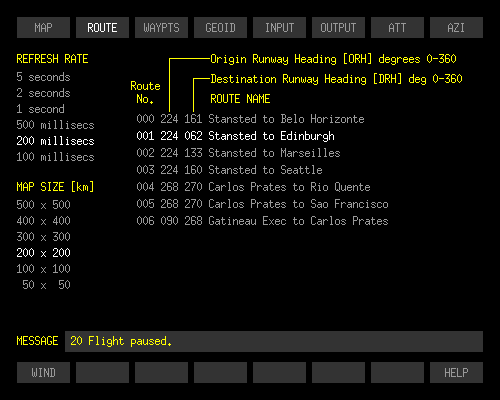 All the routes currently on file are listed here. There is one line of information for each route. The routes are numbered from zero upwards. The route number is the first item on each line. This is followed by two 3-digit numbers. These are respectively the primary runway headings of the airport at which the route begins and of the airport at which it terminates. This is followed by the route name, which comprises the names of the origin and destination airports. Provision is made within the software for up to 100 routes, although this can be extended.
All the routes currently on file are listed here. There is one line of information for each route. The routes are numbered from zero upwards. The route number is the first item on each line. This is followed by two 3-digit numbers. These are respectively the primary runway headings of the airport at which the route begins and of the airport at which it terminates. This is followed by the route name, which comprises the names of the origin and destination airports. Provision is made within the software for up to 100 routes, although this can be extended.
If there are more than 12 routes on file, a scroll bar appears on the right of the list so that all route entries may be seen by scrolling the list using the mouse wheel. A route is selected by clicking on its name. The selected route [the one that the aircraft will fly when the GO button is pressed on the MAP tab] is highlighted in bright white.
On the left of this tab are two selector menus. The upper one allows you to select the refresh period of the map. That is, how often the position of the aircraft relative to all the visible geographic features [including waypoints] is re-computed. For transoceanic legs [between one waypoint and the next] a 5-second update period is more than adequate. For short-haul and approach manoeuvres, a half-second [500 millisecond] update period is appropriate. A 100 millisecond update period is only required when the ATAV function is in use. [The ATAV function is not included in this demonstration version of the program.] The lower selector menu allows you to select the map scale for the MAP tab. In general, the 200 x 200 kilometre map is ideal. For approach in tight corridors, the 50 x 50 kilometre scale is useful. The 500 x 500 kilometre scale is ideal for waiting for first sight of your landfall waypoint after a long transoceanic leg.
The message line is where the program displays messages regarding the state of a flight and warning/error conditions. Advisory messages are displayed in green, cautionary messages in yellow and error conditions in red.
The WIND button [bottom left] enables a simulated wind to act upon the aircraft during flight. Only a single value is available. This facility could be augmented by implementing real-time access to a global wind model, which would return wind speed and direction when given the aircraft's current position and height.
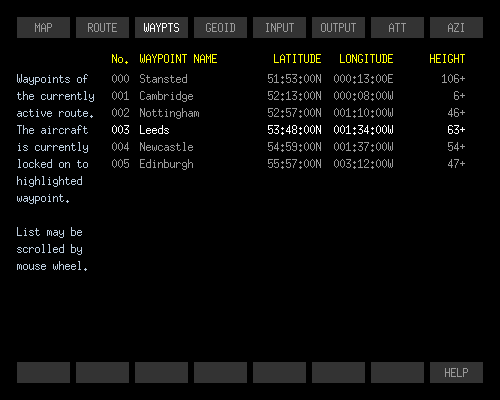 This tab contains a list of the waypoints that make up the currently selected route. A list comprising more than 16 waypoints may be scrolled using the mouse wheel. Like routes, the waypoints within a route are numbered, starting with zero. Each line of the list contains the details of 1 waypoint. Geographic features that aren't waypoints are excluded from this list. The waypoint's name is limited to 20 characters. The waypoint's latitude & longitude in degrees:minutes:seconds are then shown, followed by its elevation above sea level in metres.
This tab contains a list of the waypoints that make up the currently selected route. A list comprising more than 16 waypoints may be scrolled using the mouse wheel. Like routes, the waypoints within a route are numbered, starting with zero. Each line of the list contains the details of 1 waypoint. Geographic features that aren't waypoints are excluded from this list. The waypoint's name is limited to 20 characters. The waypoint's latitude & longitude in degrees:minutes:seconds are then shown, followed by its elevation above sea level in metres.
Clicking on a waypoint line causes it to become highlighted in bright white. This action repositions the aircraft to the highlighted waypoint, as can be seen by switching back to the MAP tab. The software currently provides for up to 50 waypoints in any given route, although this can be extended if required.
An addition at the lower left of the WAYPTS tab is a display of the maximum number of iterations that were necessary for the Vincenty computations to converge, as recorded during the current program session. A separate maximum count is shown for both the Direct Geodetic and the Inverse Geodetic computations.
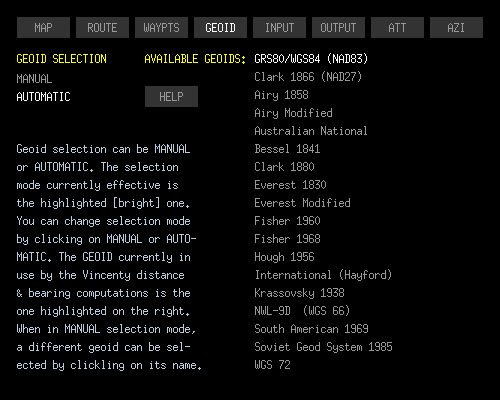 The Earth is almost spherical, but not quite. At sea level, its equatorial radius is 6378137 metres; its polar radius is 6356752 metres — a difference of only 21385 metres. Earth's sea level radius may thus be written as 6367445 ±10693 metres: that's only ± 1·21 times the height of Mount Everest. Thus, its deviation from being perfectly spherical is very small. But, for accurate navigation on a global scale, it is necessary to take account of this deviation. The Vincenty method, used by this program to calculate distance and bearing thus treats the Earth as an ellipsoid.
The Earth is almost spherical, but not quite. At sea level, its equatorial radius is 6378137 metres; its polar radius is 6356752 metres — a difference of only 21385 metres. Earth's sea level radius may thus be written as 6367445 ±10693 metres: that's only ± 1·21 times the height of Mount Everest. Thus, its deviation from being perfectly spherical is very small. But, for accurate navigation on a global scale, it is necessary to take account of this deviation. The Vincenty method, used by this program to calculate distance and bearing thus treats the Earth as an ellipsoid.
Notwithstanding, though it be a slightly flattened sphere, the Earth is not a perfect oblate ellipsoid. This is because the distribution of materials of different densities that make up the planet is far from homogeneous. This causes variations in gravitational effects. As a result, the Earth is pear-shaped. The bottom of the pear is at the South Pole and the neck of the pear is at the North Pole. Consequently, the mean ellipsoid of the Earth does not fit equally well — or even adequately — in all parts of its surface.
Over the past century and a half, therefore, various navigators and mathematicians have calculated separate ellipsoidal models [called geoids] that fit well for specific regions of the globe. The most notable and established of these are the 18 listed on the left of this tab. It is up to you to research and select the one that best suits the routes you fly.
When the selector on the left is set to MANUAL, you may click on the name of the geoid you wish the Vincenty distance and bearing function to use. When you do so, it will become highlighted in bright white as the geoid currently in effect. When AUTOMATIC is selected, the program uses the current latitude and longitude of the aircraft to select automatically the best geoid to use. The selection mechanism is, however, quite rudimentary in the present implementation. Perhaps I shall improve it in the future.
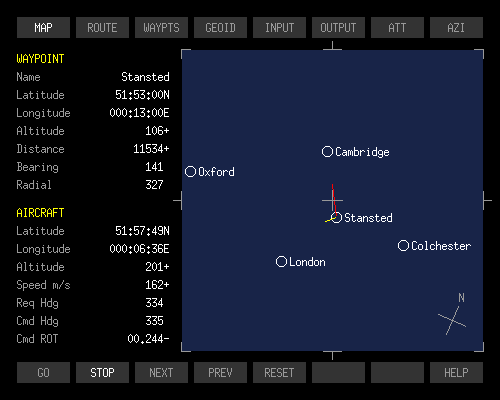 Most of this tab is occupied by a square dark blue map panel. The aircraft is represented by a cross at the centre of the map panel. The front of the aircraft always faces exactly in the upward vertical direction on the map panel. The map displays named geographic features that are currently within map range of the aircraft. Some, but by no means all, of these geographic features are designated waypoints that mark the route the aircraft is flying. All visible geographic features move downwards as the aircraft proceeds along its route, while the aircraft remains 'stationary' at the map's central cross. The small compass annunciator at the bottom right of the map indicates 'North' relative to the direction in which the aircraft is pointing.
Most of this tab is occupied by a square dark blue map panel. The aircraft is represented by a cross at the centre of the map panel. The front of the aircraft always faces exactly in the upward vertical direction on the map panel. The map displays named geographic features that are currently within map range of the aircraft. Some, but by no means all, of these geographic features are designated waypoints that mark the route the aircraft is flying. All visible geographic features move downwards as the aircraft proceeds along its route, while the aircraft remains 'stationary' at the map's central cross. The small compass annunciator at the bottom right of the map indicates 'North' relative to the direction in which the aircraft is pointing.
The items displayed on the left of the tab area show the current values of the navigational parameters. The items in the lower part show the position, height, speed, headings and turn rate of the aircraft. Those above show the position, height, distance, bearing and selected radial of approach or recession pertaining to the waypoint to which the aircraft is currently 'locked on'.
Across the bottom of the tab is a set of 8 control buttons, which may be actioned by clicking on them with the mouse. Separate GO and STOP buttons operate in mutual exclusion. That is, if the flight is in progress, clicking on the STOP button stops the flight but otherwise does nothing. Similarly, if the flight is stopped, or has not yet been started, clicking the GO button starts the flight. Otherwise it does nothing. Clicking the NEXT or PREV buttons respectively stop the flight if it is in progress and move the aircraft to the next or previous waypoint in the route. The RESET button stops the flight and sets the aircraft back to the beginning of the route. The SCALE+ [zoom-in] and SCALE- [zoom-out] buttons re-scale the map to cover a smaller area and larger area respectively. The HELP button opens this Web-based narrative.
NOTE: real flights along the sample routes provided in this demo, especially intercontinental flights, take a long time. To reduce flight time, I have used a fictitious aircraft with a top speed of 1000 metres/second [m/s]. Mach 1 = 343 m/s. The aircraft does however slow down for the turn at each waypoint and its take off and landing speed is a mere 75 m/s.





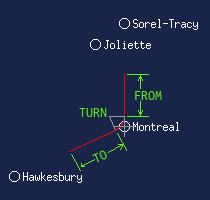 A waypoint encounter comprises three phases: a 'TO' phase, a 'TURN' phase and a 'FROM' phase. The example on the left shows the aircraft's encounter with the Montreal waypoint. The previous waypoint in the route is Hawkesbury. The next waypoint is Sorel-Tracy. The 'TO' phase of the Montreal encounter is from the half-way point between Hawkesbury and Montreal up to the point where the inbound radial touches the Montreal turning arc. The 'FROM' phase is from where the outbound radial touches the Montreal turning arc to the half-way point between Montreal and Sorel-Tracy.
A waypoint encounter comprises three phases: a 'TO' phase, a 'TURN' phase and a 'FROM' phase. The example on the left shows the aircraft's encounter with the Montreal waypoint. The previous waypoint in the route is Hawkesbury. The next waypoint is Sorel-Tracy. The 'TO' phase of the Montreal encounter is from the half-way point between Hawkesbury and Montreal up to the point where the inbound radial touches the Montreal turning arc. The 'FROM' phase is from where the outbound radial touches the Montreal turning arc to the half-way point between Montreal and Sorel-Tracy.

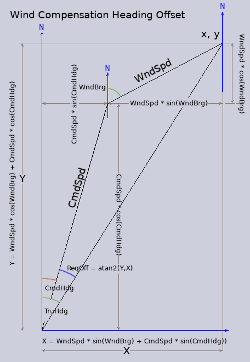
 The program then calls the Vincenty Inverse function [VSGIP()] to get the new distance [WptDst] and the forward and back bearings [FwdBrg and BakBrg]. As shown in the adjacent diagram, North at the aircraft is not the same direction as North at the waypoint, except where both are on the Equator. In the northern hemisphere the two North lines [lines of longitude] converge; whereas in the southern hemisphere they diverge. Consequently, the back bearing is not simply the forward bearing minus π/2 [180°]. Neither is the calculation a simple matter of spherical geometry: it requires an iterative convergence on an ellipsoidal geoid.
The program then calls the Vincenty Inverse function [VSGIP()] to get the new distance [WptDst] and the forward and back bearings [FwdBrg and BakBrg]. As shown in the adjacent diagram, North at the aircraft is not the same direction as North at the waypoint, except where both are on the Equator. In the northern hemisphere the two North lines [lines of longitude] converge; whereas in the southern hemisphere they diverge. Consequently, the back bearing is not simply the forward bearing minus π/2 [180°]. Neither is the calculation a simple matter of spherical geometry: it requires an iterative convergence on an ellipsoidal geoid.
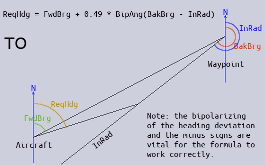

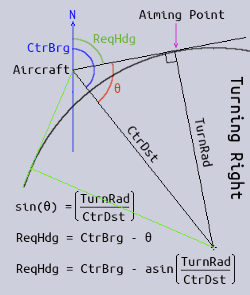
 Under certain conditions, such as high winds, the aircraft can find itself inside the turning arc. In this case, the aircraft is directed along a heading at right-angles to the turning circle radius on which the aircraft currently lies. The required heading [ReqHdg] is simply the bearing of the centre of the turning circle [the aircraft's reference point] from the aircraft − π/2 [90°].
Under certain conditions, such as high winds, the aircraft can find itself inside the turning arc. In this case, the aircraft is directed along a heading at right-angles to the turning circle radius on which the aircraft currently lies. The required heading [ReqHdg] is simply the bearing of the centre of the turning circle [the aircraft's reference point] from the aircraft − π/2 [90°].









